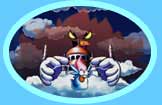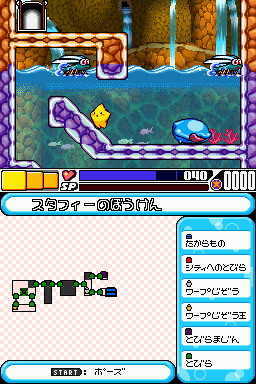List of prerelease information
From Starfy Wiki
This is a list of prerelease information from The Legendary Starfy series. For lists of unused content; a specific form of prerelease information, see this category.
Densetsu no Starfy
As Densetsu no Starfy was once being developed on both the Game Boy and the Game Boy Color rather than the Game Boy Advance the lists of prerelease information for this game will be split into two categories - "before being a Game Boy Advance title" and "as a Game Boy Advance title".
Before being a Game Boy Advance title
See also: Densetsu no Starfy (GBC).
- This game began as a Game Boy game. In November 1995, Nintendo producer Hitoshi Yamagami's boss instructed him to create some kind of 'floaty platformer'. Hitoshi Yamagami would later collaborate with TOSE producer Yasuhiro Minamimoto.[1]
- It originally went under development as a balloon-lifting game, until being reworked as a game where the player has to control a bubble with a Nintendo character in it[2] and later a floating character. Both a jellyfish and a starfish were initial considerations, and a starfish was eventually chosen for the game.
- Both a jellyfish and a starfish were initial considerations for the game, and a starfish was eventually chosen.
- Development on the game continued through 1998 and the game was reworked for the Game Boy Color.
- A trial demo of the game as a Game Boy Color title was available at Nintendo Space World 2000 at the Makuhari Messe (Japanese:幕張メッセ) exhibition centre, near Tokyo, Japan on August 25, 2000.[3]
- The game was scheduled for a release of December 2000.
- There was a debug menu.[4]
- Moe's Japanese name was "Kyororon" (Japanese: キョロロン) rather than Kyorosuke (Japanese: キョロスケ) as he is referred to in the final game.
- Preliminary artwork for the game and characters was created, including the logo, Starfy, Old Man Lobber and Moe. They are different to the official artwork used for the final game, with the exception of Moe's artwork which is used on the official Densetsu no Starfy 2 mini-site.
- The sprites of characters and enemies are considerably less detailed in the trial demo than the final game, due to the limited graphical capabilities of the Game Boy Color.
- At some point in the game's development, the Extra! option was missing from the List, and there was "push select" text above the List in English rather than the セレクトボタン ("select button") text in Japanese. Additionally, what may say "LIST" in English but is hard to read appears on the List instead of リスト ("list"). [5]
- Game Boy Encyclopedia rated Densetsu no Starfy on the 'Game Check Point' scale with top marks in 'Character' and 'Drama', and relatively well in the other categories.
- A trailer was shown at the event and another trailer was hosted on the Nintendo Space World 2000 mini-site's section for the game. (both below) [6]
- There are doors shown in the trailers without actual parts of the door except for its white outline being visible. Additionally, the white light at the end of the entrance isn't visible.
EmbedVideo was given an illegal value for the alignment parameter "middle". Valid values are "left", "center", or "right".
As a Game Boy Advance title
- The game was shown at Nintendo Space World 2001 at the same location as the Nintendo Space World 2000 event, at the Makuhari Messe (Japanese:幕張メッセ) exhibition centre, near Tokyo, Japan. The event ran from 24th August 2001. [7]
- According to the Nintendo Spaceworld Official Guidebook, the game was 60% complete.
- Some new artwork for Starfy, Old Man Lobber, the Mermaid and Ruby was made but were still changed for the final release. Moe's artwork from the Nintendo Space World 2000 trial demo was unchanged.
- The game was shown at the Next Generation World Hobby Fair on July 2002. The event was held at the Makuhari Messe convention center in the Mihamu ward, Chiba city, Japan. [8]. Wall decorations of artwork from the game were shown, as well as stuffed toys of Moe (Japanese: キョロスケ, Kyorosuke) and Old Man Lobber (Japanese: ラブじいさん, Rob-jiisan) which were hanged on the wall.
Densetsu no Starfy 2

- In the Nintendo Official Guidebook for Densetsu no Starfy 2, a sprite of Echigyoya on page 111 uses a different color palette. He is blue instead of red, has a green section on his arm instead of a brown section and has fins that are more purple. This possibly means that Echiygoya's color palette was different prior to the release of the final game.
- On pages 107 and 111 of the Nintendo Official Guidebook, the sprite of Puchi Ogura #10 has his body using a darker shade of blue. This possibly means that Puchi Ogura #10 used a different color palette prior to the release of the final game.
- In a Japanese commercial of the game, a Puchi Ogura; most likely Puchi Ogura #4 has yellow spiky hair instead of orange and has spikes the same color as his face.
Densetsu no Starfy 3

- On the official Densetsu no Starfy 3 mini-site, there is a design for Evil on the "story" page that is not used as any of Evil's two forms in the final game. It is possible that it was made before Evil's design was finished. [9]
- In the Densetsu no Starfy 3 Nintendo Official Guidebook on page 86, the Gym Clothes item appears to use a different sprite that is not used in the final game. Here, the Gym Clothes are straighter and have a gray '2' inside of a grey square instead of a black '2' inside of a black square.
Densetsu no Starfy 4

- A number of prerelease screenshots exist that show a significantly different map on the Touch Screen.
- There is a section in a separate border near the top of the touch screen that reads a certain phrase. Two of the phrases include "Starfy's adventure" (Japanese: スタフィーのぼうけん) and "Seeking a legendary beard" (Japanese: でんせつのヒゲをもとめて). (screenshots: 1, 2, 3, 4, 5)
- The border surrounding the map is blue instead of green.
- The positions of the bubbles on the border differ between these screenshots and in the final game.
- There are small icons on the border instead of pictures.
- Doors are marked as a key on the border.
- One of the icons is marked as "Treasure Item" (Japanese: たからもの) instead of "Goal" (Japanese: もくてき). This is the same name of the Treasure Items feature from Densetsu no Starfy and Densetsu no Starfy 2.
- The icon near the bottom-right side of the screen showing the Area is missing.
- The start button near the bottom of the screen is black instead of gray.
- The area that shows the start button is part of a different border than the one that contains the icon guide, unlike in the final game where the borders connect to form one horizontally flipped elongated backwards 'L' shape.
- In the final game, two icons of Starfy and stars can be seen on the bottom section of the border where the Start/Select icon is. These are missing on the prerelease screenshots.
- It appears that areas that Starfy and Starly haven't visited are marked black.
- The map isn't patterned with Moe, Warp Jizou, King Warp Jizou, stars and diamonds unlike in the final game. Instead, the background is a plain checkered design.
- In a prerelease image, a wide icon with Warp Jizou #1 (left) and King Warp Jizou (right) is used on the Lobber's Cottage Touch Screen map. In the final game, the icon is of normal size and only features Warp Jizou #1. In the final version, the icon was also moved up a little.
- In the prerelease image described in the last bullet point, the Lobber's Cottage background features walls and rock supports that are of a darker brown and do not have greenery around them. The 'fountain' from the final version is missing, but three waterfalls can be seen instead. The left-most and center-most (the center most has a hidden cave) islands with grass are missing in the prerelease image. Replacing these islands is one large island. A black spot can be seen behind the island, vaguely resembling a cave, but it is not clear what it is.
-
Screenshot from the final version showing the same lines for comparison.
The Legendary Starfy
- According to the game's ROM header, this game is codenamed "STAFY5". This applies to both the Japanese and North American releases.
References
- ↑ Interviews: Nintendo/TOSE - The Legendary Starfy - DS News @ Nintendo Life (with insight about the development of Densetsu no Starfy)
- ↑ Nintendo Power Volume 244, page 73
- ↑ Nintendo Spaceworld 2000 (in Japanese)
- ↑ Space World 2000: Hands On The Legend of Stafi - GameSpot.com
- ↑ Game Boy Encyclopedia 2001 edition, page 60
- ↑ Nintendo Space World 2000 mini-site for Densetsu no Starfy (GBC)
- ↑ Nintendo Spaceworld 2001 (in Japanese)
- ↑ 任天堂、SCEI、セガ、カプコン……数多くの新作をプレイアブルで体験できる「第16回次世代ワールドホビーフェア」 - GAME Watch (in Japanese)
- ↑ ものがたり - Densetsu no Starfy 3 official mini-site (in Japanese)
| List of prerelease information | Densetsu no Starfy • Densetsu no Starfy 2 • Densetsu no Starfy 3 • Densetsu no Starfy 4 • The Legendary Starfy |
|---|---|
| Lists of unused content | Densetsu no Starfy • Densetsu no Starfy 2 (test stage) • Densetsu no Starfy 3 (test stage) • Densetsu no Starfy 4 (test stage, unused models) • The Legendary Starfy (Helpful Stuff, test stage) • Test Stages (general information) |
| Unreleased games | Unused balloon/bubble pushing games / Densetsu no Starfy (Game Boy/Color) |
| Events and TV shows | Nintendo Space World (2000, 2001) • World Hobby Fair (2002, 2006) • Oha Suta • E3 (2009) |
| Media with relevant information | Game Boy Encyclopedia • Gekkan Nintendo • Nintendo Dream • Nintendo Power • Nintendo Spaceworld Official Guidebooks • Websites |